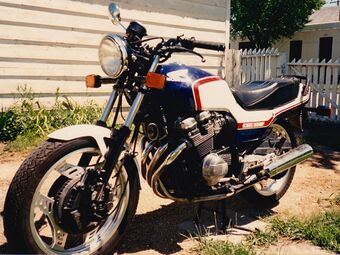Engineering:Honda CBX550F
 | |
| Manufacturer | Honda Motor Company |
|---|---|
| Also called | CBX550 Four |
| Production | 1982–1986 |
| Class | Sport touring |
| Engine | 572.5 cc (34.94 cu in) Four stroke in-line four |
| Bore / stroke | 59.2 mm × 52.0 mm (2.33 in × 2.05 in) |
| Compression ratio | 9.5:1 |
| Ignition type | Transistorised |
| Transmission | 6-speed manual, chain final drive |
| Frame type | Duplex cradle; tubular steel |
| Suspension | Telescopic with air assistance front: cantilever with air assistance, rear[1] |
| Brakes | Front: Twin hydraulic disc Rear: single hydraulic disc |
| Tyres | 3.60H18-4PR, front: 4.10H18-4PR, rear |
| Wheelbase | 1.380 m (4 ft 6.3 in) |
| Dimensions | L: 2.085 m (6 ft 10.1 in) W: 0.740 m (2 ft 5.1 in) H: 1.080 m (3 ft 6.5 in) (F) 1.270 m (4 ft 2.0 in) (F II) |
| Seat height | 0.785 m (2 ft 6.9 in) |
| Weight | 184 kg (406 lb) (F) 190 kg (420 lb) (F II)[2] (dry) |
| Fuel capacity | 17.0 L (3.7 imp gal; 4.5 US gal) |
| Oil capacity | 3.0 L (0.66 imp gal; 0.79 US gal) |
| Related | Honda CBX1000 Honda CBX750 Honda CBX650 Honda CBX400F Honda CBX250 |
The Honda CBX550F is a four-stroke, in line four cylinder, sport tourer motorcycle produced from 1982 to 1986 by the Honda Motor Company.[3] The CBX550F II is identical apart from the addition of a half-fairing.[2]
Although the model was designated 550, the actual capacity was 572.5 cc (34.94 cu in).[3] Honda developed a completely new, unusual design of engine to compete in the middleweight-sector with twin overhead camshafts acting on rockers, having screw-adjusters for clearance which actuated the sixteen valves (four per cylinder).
The engine featured a standard oil-cooler and a distinctive, unusual exhaust system, a first for Honda, with cross-over pipes directly in front of the engine linking cylinders one to four and a separate pair of pipes connecting cylinders two and three. The CV carburettors were of a new type using mixture-enriching internal fuel passages for cold-starts, with careful engineering of the inlet tracts to achieve smooth gasflow.[4]
The machine was noted for its use of inboard ventilated disc brakes, the discs themselves being contained within a "drum" type enclosure.[2] Front suspension was by oil-damped telescopic fork with air assistance and incorporating an anti-dive mechanism in the left fork leg.[2] Rear suspension was by Honda's own "Pro-Link" rising rate system, which allows the suspension forces to vary in accordance with rear wheel movement.[2] The machine was equipped with transistorised ignition and electrics were 12 volt.
See also
- Honda CBX series
- Honda CBX (disambiguation)
References
- Footnotes
- ↑ Shoemark, Pete (1989). Honda CBX550 572.5cc 1982 to 1986: Owners Workshop Manual. Haynes. p. 90. ISBN 0856969400.
- ↑ 2.0 2.1 2.2 2.3 2.4 Shoemark, Pete (1989). Honda CBX550 572.5cc 1982 to 1986: Owners Workshop Manual. Haynes. p. 6. ISBN 0856969400.
- ↑ 3.0 3.1 Shoemark, Pete (1989). Honda CBX550 572.5cc 1982 to 1986: Owners Workshop Manual. Haynes. ISBN 0856969400.
- ↑ Motor Cycle News (UK weekly newspaper) 5 May 1982, p.21 Honda CBX550.This gem sets new standards, Terry Snelling. Accessed and added 2015-11-02
- Sources
Where not already otherwise noted, specifications obtained from, Shoemark, Pete (1989). Honda CBX550 572.5cc 1982 to 1986: Owners Workshop Manual. Haynes. ISBN 0856969400.
 |

